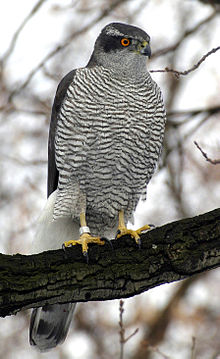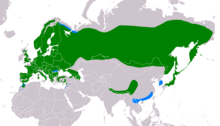
Back Habicht ALS Accipiter gentilis AN Goshafoc ANG باز أوراسي Arabic باز شمالى ARZ Accipiter gentilis AST Хъарчигъа AV Tetraçalan Azerbaijani بایاغی چاکیر قۇشو AZB Ҡор ҡарсығаһы Bashkir
| Eurasian goshawk | |
|---|---|

| |
| Adult | |
| Scientific classification | |
| Domain: | Eukaryota |
| Kingdom: | Animalia |
| Phylum: | Chordata |
| Class: | Aves |
| Order: | Accipitriformes |
| Family: | Accipitridae |
| Genus: | Accipiter |
| Species: | A. gentilis
|
| Binomial name | |
| Accipiter gentilis | |
| Subspecies | |
| |

| |
| Range of A. gentilis Resident Non-breeding
| |
| Synonyms | |
|
Falco gentilis Linnaeus, 1758 | |
The Eurasian goshawk (/ˈɡɒsˌhɔːk/; Accipiter gentilis) is a species of medium-large bird of prey in the family Accipitridae, a family which also includes other extant diurnal raptors, such as eagles, buzzards and harriers. As a species in the genus Accipiter, the goshawk is often considered a "true hawk".[3] The scientific name is Latin; Accipiter is "hawk", from accipere, "to grasp", and gentilis is "noble" or "gentle" because in the Middle Ages only the nobility were permitted to fly goshawks for falconry.[4]
It is a widespread species that inhabits many of the temperate parts of the Eurasia.[5] Except in a small portion of southern Asia, it is the only species of "goshawk" in its range and it is thus often referred to, both officially and unofficially, as simply the "goshawk". It is mainly resident, but birds from colder regions migrate south for the winter.[5] As of 2023, the goshawks found primarily in North America are no longer considered Accipiter gentilis, but are now designated as the American goshawk (Accipiter atricapillus).[6][7]
- ^ BirdLife International (2016). "Accipiter gentilis". IUCN Red List of Threatened Species. 2016: e.T22695683A93522852. doi:10.2305/IUCN.UK.2016-3.RLTS.T22695683A93522852.en. Retrieved 12 November 2021.
- ^ "Astur gentilis schvedowi AVIS-IBIS". 10 September 2014.
- ^ Brown, Leslie; Amadon, Dean (1986). Eagles, Hawks and Falcons of the World. Wellfleet. ISBN 978-1555214722.
- ^ Jobling, James A. (2010). The Helm Dictionary of Scientific Bird Names. London: Christopher Helm. pp. 30, 171–172. ISBN 978-1-4081-2501-4.
- ^ a b Ferguson-Lees, James; Christie, David A. (2001). Raptors of the World. Houghton Mifflin Harcourt. ISBN 978-0-618-12762-7.
- ^ Gill, Frank; Donsker, David; Rasmussen, Pamela, eds. (December 2023). "Hoatzin, New World vultures, Secretarybird, raptors". IOC World Bird List Version 14.1. International Ornithologists' Union. Retrieved 26 June 2024.
- ^ Chesser, R.T.; Billerman, S.M.; Burns, K.J.; Cicero, C.; Dunn, J.L.; Hernández-Baños, B.E.; Jiménez, R.A.; Kratter, A.W.; Mason, N.A.; Rasmussen, P.C.; Remsen, J.V.J.; Winker, K. (2023). "Sixty-fourth supplement to the American Ornithological Society's Check-list of North American Birds". Ornithology. 140 (3): 1–11 [4]. doi:10.1093/ornithology/ukad023.
